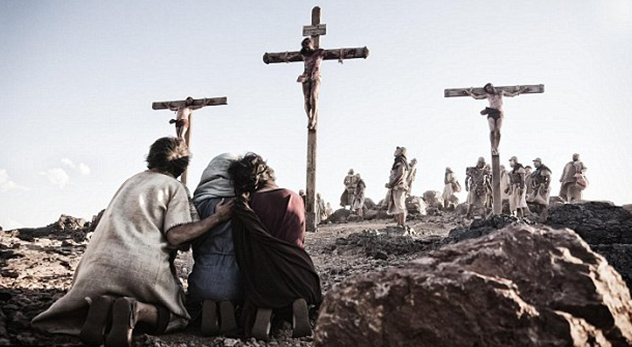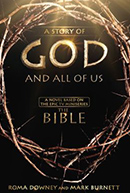The response was divided to my column last week on 10 inaccuracies in “The Bible” miniseries. Some felt I was attacking a noble effort to spread the Christian message; others were angry that the series creators took so much artistic license. Others still pointed out other inaccuracies I missed. (For example, there is no record in the scriptures of Jesus entering the tomb of Lazarus, but rather it says Jesus called to him from outside.)
I’ve stated that I was not upset by the show’s inaccuracies since they did not compromise the meta-story of the Scriptures themselves. We should expect some deviations whenever a story is moved from one medium to another, and most of the changes were implemented in order to cover as much narrative as possible in a limited amount of time.
My piece was written after the fourth episode, however, and the finale has since aired. The two-hour conclusion left many of the more than 10 million viewers in tears and shock. Yet, in the spirit of my previous article, some may be wondering how accurate the finale of “The Bible” was. Did it stick to the story or take significant artistic licenses?
As it turns out, the fifth installment of the epic miniseries fell in line with the other four. It stayed mostly true to the spirit of the original narrative, and did not damage the overall story captured by the Bible’s authors. Here are seven I noticed, listed in chronological order:
1. A different denial. In the scripture, Peter first denies Jesus when questioned by a servant girl in the courtyard of the high priest’s residence. It seems to be both cold and sometime in the evening or at night because she saw his face by the light of a fire they had kindled. (Luke 22:55-57) In the series, however, he is questioned by a temple guard in broad daylight while Jesus stands before the crowd.
2. Where’s Herod? The series depicts Pilate making a unilateral decision to execute Jesus and Herod is nowhere to be found, but the Bible tells a different story. In the scriptures, Pilate sends Jesus to Herod because He actually fell under Herod’s jurisdiction. Herod decides not to condemn him, but rather returns him to Pilate, giving the prefect authority to make the decision. (Luke 23:7)
3. Mary rides solo. In the series, Mary is alone when she discovers the empty tomb. The resurrection narratives in the Biblical gospels are admittedly filled with seeming contradictions and are the most difficult to harmonize, but when taken together one can conclude that several women witnessed the empty tomb on the day of Jesus’ resurrection. Matthew says that Mary Magdalene and “the other Mary” went to the tomb together. (Matthew 28:1) Luke says that the two Marys were joined by “Joanna…and the others with them.” (Luke 24:9-10) Mark mentions the two Marys and “Salome.” (Mark 16:1-2) John only mentions Mary Magdalene (John 20:1-2), but he doesn’t say that she came alone.
4. Where have the guards gone? The scriptures say that Roman soldiers were posted at Jesus’ tomb to ensure no one could the body. In the series, however, no guards are present. Matthew’s telling of the resurrection asserts that the guards were present and afraid—“they shook and became like dead men.” (Matthew 28:4) The guards then return to the priests to report what has happened (vv. 11-15), though in the miniseries, the priests hear reports much later.
5. Peter is convinced…or is he? In the series, when Peter goes to the tomb to verify Mary’s testimony, he realizes immediately that Jesus has returned from the dead. “Gone?” says Peter with the score dramatically rising, “No. He’s back.” But this is not what the Bible asserts. Luke says, Peter left the tomb “wondering to himself what has happened.” And John mentions that though they now believe Mary that the tomb is empty, they haven’t concluded what has really occurred. John 20:9: “For as yet, they did not know the Scripture, that He must rise again from the dead.”
6. The Sanhedrin-less stoning of Stephen. Stephen is stoned by an angry mob in an open space after Paul incites them to kill him. At least that’s how it happens in the series. The Biblical text, however, records that Stephen was dragged before the Sanhedrin who gave him over to be stoned outside of the city after he angers them with a sermon (Acts 7).
7. Paul’s “baptism.” The series inserts a theatrical scene where Paul is “baptized” by Ananias after his sight is restored. Ananias takes a jug of water and pours it over his head saying, “I, Ananias, baptize you, Paul, in the name of Jesus Christ.” This event never appears in the Bible itself, at least not like this. The scripture says that Paul was baptized after his sight is restored but the details are left to readers imaginations. Many Christians—particularly Baptists—will take exception with the form of baptism shown in the series. The Greek word for “baptism” in the Bible means “to dip or immerse,” so some will argue that even if Ananias baptized Paul, it would not have happened like the series claims.
“The Bible” producers, Mark Burnett and Roma Downey, have released a novel based on the series titled, The Story of God and All of Us. It is available now and has already become a New York Times bestseller.







